Have you ever wondered what the night sky looked like before artificial lights polluted it? Have you ever dreamed of seeing the Milky Way in all its glory or witnessing a shooting star streak across the sky? If so, you’re in luck.
Rocky Mountain National Park is one of the best places in the world to go stargazing, and this guide will show you how to make the most of it.
In this article, you get to
Discover the Uniqueness of Rocky Mountain National Park Stargazing: Learn why this park is a stargazer’s paradise with its ideal location and dark skies.
Understand the Importance of Preserving Dark Skies: Explore the benefits of preserving dark skies for humans and wildlife.
Find the Best Time for Stargazing: Learn about the impact of moon phases and seasonal changes on your stargazing experience.
Use Clear Sky Predictions and Local Weather Conditions: Discover the importance of monitoring weather conditions for a successful stargazing adventure.
Identify Top Locations for Stargazing: Explore some of the best spots in the park, including Forest Canyon Overlook, Trail Ridge Road, Mills Lake, Bear Lake, and campgrounds.
Learn About Phenomena to See in the Night Sky: Understand how to identify constellations and planets, including The Big Dipper, Polaris, Cassiopeia, Orion, Sirius, Venus, Jupiter, and Saturn.
Witness the Milky Way and Deep Sky Objects: Learn how to appreciate the Milky Way and discover deep sky objects like the Andromeda Galaxy, Orion Nebula, and Pleiades.
Attend the Night Sky Festival and Park Programs: Get details on the annual Night Sky Festival and its various activities.
Prepare with Essential Stargazing Gear: Understand the clothing, accessories, and equipment needed for a comfortable and successful stargazing experience.
Capture the Night Sky with Astrophotography: Discover tips on photographing the Milky Way, creating star trail images, and editing your astrophotography.
By the end of this article, you’ll be well-equipped and inspired to embark on an unforgettable stargazing journey in Rocky Mountain National Park, with a deep appreciation for both the natural beauty of the park and the wonders of the night sky.
Let’s dive right in.
Introduction To Rocky Mountain National Park Stargazing

Uniqueness of the park for stargazing
Rocky Mountain National Park is a stargazer’s paradise. The park covers over 400 square miles of rugged mountains, alpine lakes, forests, and meadows in Colorado.
The park’s high elevation, low humidity, and remote location make it ideal for observing the night sky. The park has some of the darkest skies in the country, with minimal light pollution from nearby towns and cities.
Rocky Mountain National Park is one of the best places to stargaze in Colorado.
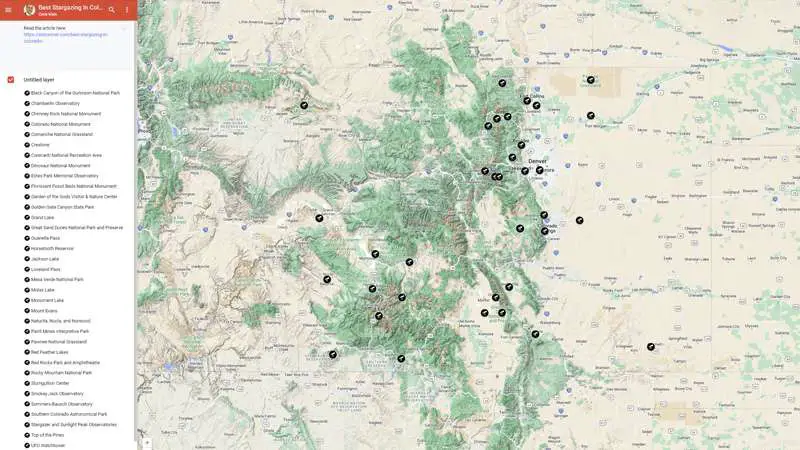
The park is working towards becoming an International Dark Sky Park, a designation by the International Dark Sky Association that recognizes places that preserve and protect dark skies for future generations.
FREE STARGAZING CHECKLIST
My 5-page Stargazing Checklist will enhance your astronomical observations.
Follow this free checklist to navigate the night sky with confidence, clarity, and a sense of preparedness for a rewarding stargazing experience.

Importance of preserving dark skies
Dark skies are not only beautiful but also essential for life on Earth. They provide many benefits for humans and wildlife, such as:
- Improving our health and well-being by regulating our circadian rhythms, enhancing our mood, and boosting our immune system.
- Reducing our energy consumption and greenhouse gas emissions by using less artificial lighting.
- Supporting biodiversity and ecosystem services by allowing nocturnal animals to hunt, migrate, and reproduce without disruption.
- Enriching our culture and heritage by inspiring art, science, religion, and philosophy.
- Educating and entertaining us by revealing the wonders of the universe and our place in it.
Unfortunately, dark skies are becoming increasingly rare due to urbanization, development, and technology.
According to a Light Pollution Science and Technology Institute study, more than 80% of the world’s population lives under light-polluted skies, and 99% of the U.S. and European populations do. This means many people never get to see the stars as they truly are or experience the awe and wonder they evoke.
That’s why preserving dark skies in places like Rocky Mountain National Park is essential, where we can still enjoy them and appreciate their value. By star gazing in the park, we can also raise awareness and support for dark sky conservation efforts.
Best Time for Stargazing in Rocky Mountain National Park
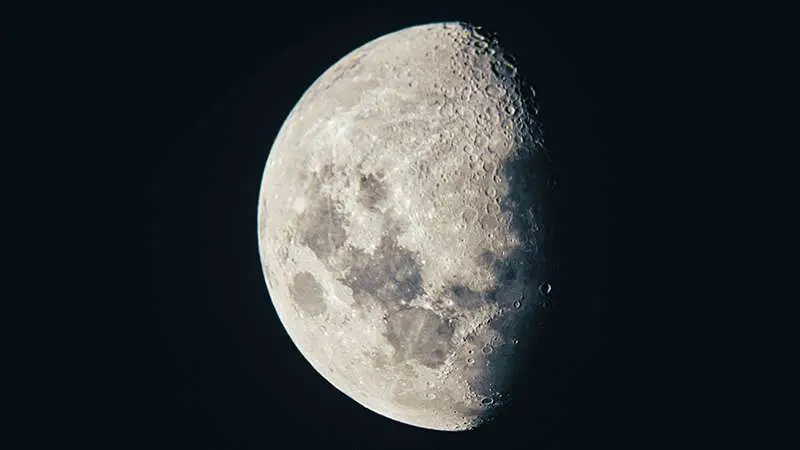
Understanding moon phases
The best time for stargazing in Rocky Mountain National Park depends on several factors, but one of the most important is the moon phase.
The moon is a beautiful celestial object, but it can also be a source of light pollution that washes out fainter stars. Therefore, to see the most stars possible, you should avoid nights when the moon is full or nearly full. Instead, it would be best if you aimed for nights when the moon is new, crescent, sets early, or rises late.
Before planning your trip, you can check the moon phases and times online or with an app.
Seasonal changes and their impact
Another factor that affects stargazing in Rocky Mountain National Park is the season. The park has four distinct seasons, each with its own advantages and disadvantages for stargazing.
Here are some general tips for each season:
- Spring: Spring is an excellent time to see constellations such as Orion, Gemini, Taurus, and Canis Major in the evening sky. However, spring can also be unpredictable regarding weather and road conditions. Some roads may be closed due to snow or ice until late May or early June. Be prepared for cold temperatures and possible storms.
- Summer: Summer is a popular time to visit the park and enjoy its many activities. It’s also a great time to see the Milky Way arching across the sky from south to north. However, summer also has some drawbacks for stargazing. The nights are shorter and warmer, which means less darkness and more atmospheric turbulence. Summer also brings more visitors and traffic to the park, which can increase light pollution and noise.
- Fall: Fall is a beautiful time to see the park’s changing colors and wildlife. It’s also good to see constellations such as Cygnus, Lyra, Aquila, and Sagittarius in the evening sky. However, fall can also be chilly and windy, especially at higher elevations. Be prepared for frost and possible snow.
- Winter: Winter is a quiet and peaceful time to visit the park and enjoy its snowy scenery. It’s also a great time to see constellations such as Cassiopeia, Perseus, Auriga, and Andromeda in the evening sky. However, winter also has some challenges for stargazing. The nights are longer and colder, which means more darkness and discomfort. Winter also brings more road closures and limited services to the park, which can limit your access and options.
Ultimately, the best season for stargazing in Rocky Mountain National Park depends on your preferences and goals. No matter what your chosen season is, you’ll find something unique to see in the night sky.
Clear sky prediction and local weather conditions
The final factor that affects stargazing in Rocky Mountain National Park is the weather.
The weather in the park can change quickly and dramatically, depending on the altitude, terrain, and time of year. Clouds, fog, rain, snow, wind, and lightning can all ruin your stargazing plans. Therefore, it’s essential to check the weather forecast before you go and be flexible and adaptable if the conditions are unfavorable.
One of the best ways to check the weather for stargazing is to use a clear sky chart, which shows the cloud cover, transparency, seeing, darkness, and temperature for a specific location and time. You can find clear sky charts for several places in the park online or use an app to find the nearest one.
Top Locations for Stargazing in the Park
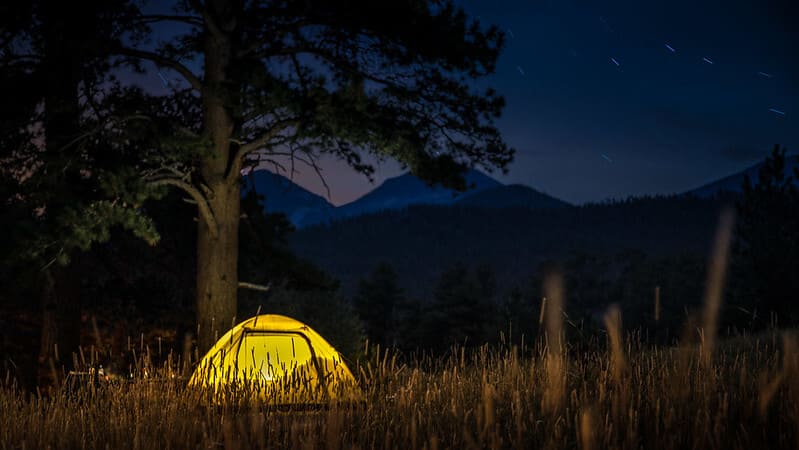
Forest Canyon Overlook
Forest Canyon Overlook is one of the best locations for stargazing in Rocky Mountain National Park. This overlook is along Trail Ridge Road, about 15 miles from Estes Park or 10 miles from Grand Lake.
It offers stunning views of the Continental Divide and the Never Summer Mountains and a wide-open sky above. The overlook is at an elevation of 11,716 feet, which means less atmospheric interference and more stars. However, it also means colder temperatures and possible altitude sickness. Be sure to dress warmly and drink plenty of water.
Trail Ridge Road
Trail Ridge Road is another excellent location for stargazing in Rocky Mountain National Park. This road is the highest continuous paved road in North America, reaching an elevation of 12,183 feet at its highest point.
It crosses the park from east to west, offering spectacular views of the mountains and valleys. The road has several pull-offs where you can park your car and enjoy the night sky. However, be aware that the road is narrow, winding, and steep in some places, and it may be closed due to weather or construction at any time. Drive carefully and follow the park rules.
Mills Lake
If you’re looking for a more adventurous location for stargazing in Rocky Mountain National Park, consider trying Mills Lake.
This lake is one of the most scenic destinations in the park, surrounded by peaks such as Longs Peak, Thatchtop Mountain, and Glacier Gorge. The lake is accessible by a 5.6-mile round-trip hike from the Glacier Gorge Trailhead on Bear Lake Road. The hike is moderate in difficulty, with some elevation gain and rocky terrain.
The lake offers a serene and secluded spot for stargazing, with reflections of the stars on the water. However, be prepared for a long walk in the dark, and bring a flashlight or headlamp.
Bear Lake
A more accessible location for stargazing in Rocky Mountain National Park is Bear Lake.
This lake, located at the end of Bear Lake Road, is one of the most popular attractions in the park. It’s a short walk from the parking lot to the lake shore, where you can admire the views of Hallett Peak and Flattop Mountain.
The lake is also a good place to see the Milky Way rising over the mountains in summer. However, this location can be crowded during peak seasons and hours, so you should arrive early or late to avoid the crowds.
Sprague Lake
A more accessible location for stargazing in Rocky Mountain National Park is Sprague Lake.
This lake, located near the Glacier Basin Campground on Bear Lake Road, is one of the most popular attractions in the park.
It’s a short walk from the parking lot to the lake shore, where you can admire the views of the Continental Divide and the Mummy Range. The lake is also a perfect place to see the moon and planets reflecting on the water.
However, this location can be affected by light pollution from nearby towns and campgrounds, so you may choose a darker spot if you’re looking for fainter stars.
Campgrounds as prime stargazing locations
Another option for stargazing in Rocky Mountain National Park is to stay at one of the park’s campgrounds. The park has five drive-in campgrounds, two group campgrounds, and several backcountry campsites.
Camping in the park allows you to enjoy the night sky from your tent or RV without driving or hiking in the dark. You can join other campers and rangers for stargazing programs and activities at some campgrounds.
However, be aware that camping in the park requires a reservation and a fee and that some campgrounds may be closed or full during peak seasons.
What to Expect: Phenomena to See in the Night Sky
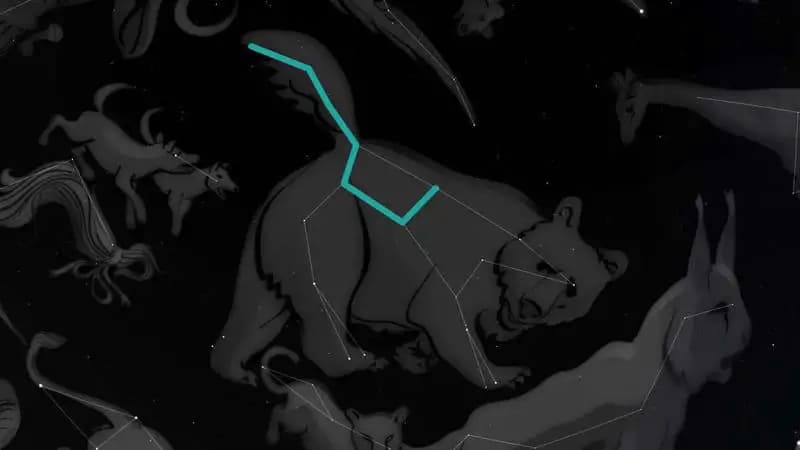
Identifying constellations and planets
Stargazing in Rocky Mountain National Park becomes an engaging adventure when you identify constellations and planets. Here’s how to enjoy this fundamental and enjoyable aspect of stargazing:
Constellations:
- Constellations are star patterns with cultural and mythological associations.
- Utilize a star chart, guidebook, or stargazing app to locate and identify constellations.
- Exercise your creativity by inventing your constellations and stories.
Prominent Constellations and Planets:
- The Big Dipper: Seven bright stars forming a ladle or plow shape, part of Ursa Major (the Great Bear). It is visible year-round in the northern sky and is helpful for finding other stars and constellations.
- Polaris (North Star): The brightest star in Ursa Minor (Little Bear), nearly directly above the North Pole. Locate Polaris by extending a line from the two pointer stars at the Big Dipper’s bowl.
- Cassiopeia: Forms a W or M shape in the northern sky, opposite the Big Dipper across Polaris. It features five bright stars and aids in finding other celestial objects.
- Orion: A recognizable constellation in the shape of a hunter. It is visible in winter and spring in the southern sky. It is notable for its four bright stars forming a rectangle, three-star belt, and two-star sword.
- Sirius (Dog Star): The brightest star in the night sky, part of Canis Major (Big Dog). Follows Orion across the sky and is visible in winter and spring in the southern sky.
Prominent Planets:
- Venus: Second planet from the sun, known as the Morning Star or Evening Star, depending on its appearance. It is visible near the horizon before sunrise or after sunset, often brighter than stars.
- Jupiter: Fifth planet from the sun, the largest and most massive in the solar system. Appears at various times of the year, usually brighter than most stars except Sirius and Venus.
- Saturn: Sixth planet from the sun, known for its stunning ring system. It is visible at different times depending on its position. It is generally dimmer than Jupiter but brighter than most stars.
Remember, these are just a few constellations and planets you can explore in the night sky. Depending on your equipment and conditions, you can also search for nebulas, galaxies, comets, and asteroids, adding more celestial wonders to your stargazing experience in the park.
Watching meteor showers
Enjoy the thrill of watching meteor showers during your stargazing adventure in Rocky Mountain National Park. Meteor showers are captivating celestial events where numerous meteors, or shooting stars, simultaneously light up the night sky. Here’s how to make the most of this experience:
Meteor Showers:
- Meteors are small particles that burn up as they enter Earth’s atmosphere at high speeds.
- Meteor showers occur when Earth passes through debris from comets or asteroids.
Notable Meteor Showers:
- Perseids (Mid-July to Late August, Peak: August 12-13):
- It was named after the Perseus constellation.
- It can produce up to 100 bright and fast meteors per hour at their peak.
- Geminids (Early to Mid-December, Peak: December 13-14):
- It was named after the Gemini constellation.
- It is known for colorful and slower meteors, with up to 120 per hour at peak.
- Leonids (Mid-November to Late November, Peak: November 17-18):
- It was named after the Leo constellation.
- It varies in intensity but can produce spectacular outbursts every 33 years, with thousands of meteors per hour.
Watching a Meteor Shower:
- Find a dark, open location away from city lights and obstructions.
- Check moon phase and weather conditions for optimal visibility.
- No special equipment is required, just your eyes and patience.
- Lie on a blanket or chair and gaze up toward the radiant (where meteors appear to originate).
- Allow your eyes 20 minutes to adjust to the darkness for the best viewing experience.
Watching a meteor shower is a thrilling and accessible way to immerse yourself in the wonders of the night sky in Rocky Mountain National Park.
Understanding the Milky Way and deep sky objects

Stargazing in Rocky Mountain National Park offers a chance to witness the awe-inspiring Milky Way and deep sky objects. Here’s how to experience these celestial wonders:
The Milky Way:
- Find a dark location free from light pollution.
- Check moon phase and weather conditions for optimal visibility.
- No special equipment is needed, just your eyes and imagination.
- Look for a faint band of light spanning the sky (north to south in summer, east to west in winter).
- Observe key features like the core, arms, bulge, and dark rifts.
Deep Sky Objects:
- Utilize optical aids like binoculars or a telescope.
- Use a star chart or app to locate these objects in the sky.
- Identify faint fuzzy patches or dots with varying shapes, colors, and sizes.
- Explore their names, distances, types, and histories.
Notable Deep Sky Objects:
- Andromeda Galaxy: Nearest major galaxy, visible with the naked eye. It is found in the Andromeda constellation. Resembles a sizeable oval-shaped smudge of light. It is located 2.5 million light-years away and holds about a trillion stars.
- Orion Nebula: Giant cloud of gas and dust, a stellar nursery. It appears in the Orion constellation as a bright fuzzy spot below Orion’s belt. It is situated 1,300 light-years away, spanning about 24 light-years across.
- Pleiades: Cluster of young, hot stars known as the Seven Sisters. It is found in the Taurus constellation. Appears as a small group of bright stars often mistaken for the Little Dipper. It is located 400 light-years away and contains around 1,000 stars.
- Witnessing the Milky Way and deep sky objects in Rocky Mountain National Park promises a breathtaking and enlightening experience.
To learn more about seeing the Milky Way in Colorado, read my article Where Can You See the Milky Way in Colorado?
Night Sky Festival and Park Programs
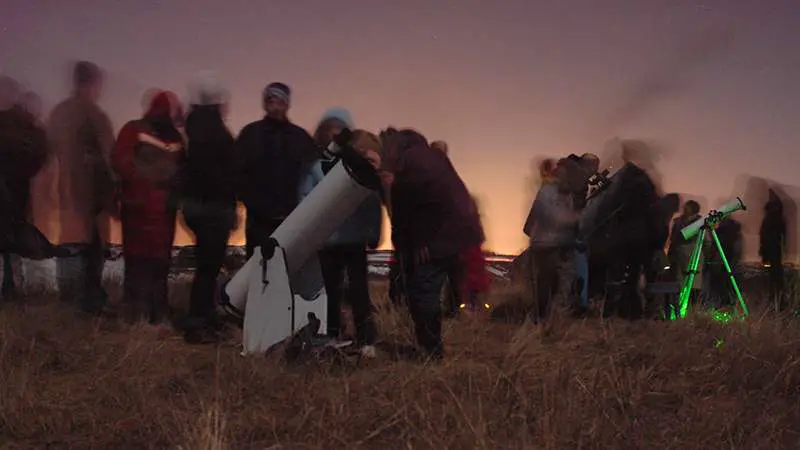
The annual Night Sky Festival
If you’re looking for a unique way to enjoy stargazing in Rocky Mountain National Park, consider attending the annual Night Sky Festival.
This three-day event celebrates the park’s dark skies and offers a variety of activities for visitors of all ages and interests. The festival usually occurs in late August or early September when the weather is mild, and the skies are clear.
Some of the activities that you can expect at the Night Sky Festival are:
- Astronomy presentations: You can learn more about the night sky and astronomy from experts and enthusiasts who will share their knowledge and passion with you. You can attend lectures, workshops, demonstrations, and panel discussions on various topics such as constellations, planets, meteors, galaxies, telescopes, astrophotography, and more.
- Stargazing parties: You can join other stargazers and astronomers who will guide you through the night sky and show you its wonders. You can use your equipment or borrow some from the park or its partners. You can also enjoy music, stories, games, and snacks while you stargaze.
- Astro-arts: You can express your creativity and appreciation for the night sky through art. You can participate in contests, workshops, exhibits, and performances that involve painting, drawing, photography, poetry, music, dance, and more.
- Astro-kids: You can have fun and learn with your kids or grandkids who will love the night sky festival. You can engage in activities designed for children and families, such as crafts, scavenger hunts, puppet shows, planetarium shows, and more.
To attend the Night Sky Festival, check the park’s website for the dates, locations, schedules, fees, and registration details. You can also volunteer or donate to support the festival and its partners.
Essential Stargazing Gear
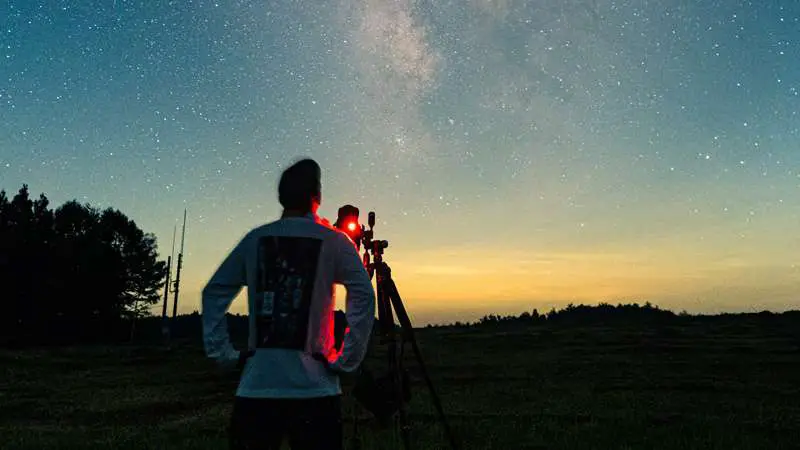
Necessary clothing and accessories
Prepare for a comfortable and safe stargazing experience in Rocky Mountain National Park by dressing appropriately and bringing essential clothing and accessories:
1. Layered Clothing:
- Base layer to wick moisture.
- Mid layer for insulation.
- Outer layer for wind and rain protection.
- Extra layers for adjustment as needed.
2. Hat, Gloves, and Scarf:
- A warm hat that covers your ears.
- Gloves that allow equipment operation.
- A scarf for neck and mouth coverage.
3. Boots and Socks:
- Sturdy, waterproof, and comfortable boots.
- Thick, warm, and breathable socks.
- Avoid open, thin, or tight footwear.
4. Blanket or Sleeping Bag:
- Stay warm and cozy while stargazing.
- Choose according to the season and temperature.
5. Flashlight or Headlamp:
- Ensure visibility in the dark.
- Opt for a red-light mode to preserve night vision.
- Carry extra batteries or a charger.
6. Water and Snacks:
- Stay hydrated, especially at high altitudes.
- Choose nutritious and easily digestible snacks.
- Being well-prepared will make your stargazing adventure in the park more enjoyable and comfortable.
Useful equipment: Binoculars, Telescopes, Apps
Enhance your stargazing experience in Rocky Mountain National Park with some helpful equipment. Depending on your interest and expertise, consider the following options:
1. Binoculars:
- Handheld and affordable.
- Portable and versatile.
- Magnify distant objects.
- Suitable for stars, planets, moons, clusters, nebulas, and galaxies.
- Limitations include low magnification, a narrow field of view, and potential image shake.
2. Telescopes:
- More powerful and complex.
- Specialized for astronomy.
- Reveal details, colors, shapes, and features.
- Challenges include size, weight, setup, alignment, maintenance, and cost.
3. Apps:
- Convenient and interactive.
- Offer information, images, maps, guides, quizzes, and games.
- Customizable and updatable.
- Drawbacks include battery drain, screen glare, data usage, and accuracy.
When choosing equipment, consider your goals, budget, skills, and preferences. Experiment with different types before purchasing or explore borrowing options from the park or its partners. Enhance your stargazing adventure with the right tools.
Astrophotography Tips

How to capture the Milky Way
Are you interested in capturing the beauty of the night sky in Rocky Mountain National Park? Try astrophotography, the art of photographing stars and celestial objects. It’s rewarding and challenging, requiring equipment, knowledge, and practice.
Capturing the Milky Way:
- Locate a Dark Spot: Using a light pollution map or app, find a location free from city lights.
- Choose the Right Time: Opt for moonless or crescent moon nights when the Milky Way is visible.
- Set Up Your Camera: Use manual mode (M) for full control.
- Equip a wide-angle lens (10-35mm) to capture more sky.
- Manually focus on infinity or a distant object.
- Use a wide aperture (f/2.8-f/4) for more light.
- Set a longer shutter speed (15-30 seconds) for Milky Way details.
- Increase ISO (1600-6400) for better sensitivity.
- Apply a cool white balance (3000-4000K) for vibrant colors.
- Capture the Moment: Use a remote shutter release or a self-timer to prevent camera shake. Take multiple shots with different settings and angles.
- Post-Processing: Enhance your photo using editing software or an app. Adjust contrast, brightness, saturation, sharpness, and noise reduction to perfect your shot.
Astrophotography lets you unveil the wonders of the night sky in Rocky Mountain National Park. Capture the Milky Way’s splendor with these steps.
Using long exposure for star trail images
Get creative with your astrophotography in Rocky Mountain National Park by trying your hand at star trail images. These captivating shots showcase the mesmerizing motion of stars due to Earth’s rotation. Here’s how to create them:
1. Find the Perfect Spot:
- Seek a dark location far from city lights using a light pollution map or app.
2. Time it Right:
- Opt for moonless or crescent moon nights.
- Ensure a stable setup and adjust camera settings accordingly.
3. Camera Settings:
- Choose manual mode (M) or bulb mode (B) for full control.
- Employ a wide-angle lens (10-35mm) for a broader sky view.
- Manually focus on infinity or a distant object.
- Use a large aperture (f/2.8-f/4) to capture more light.
- Set a long shutter speed (minutes to hours).
- Control the shutter with a remote release or intervalometer.
- Keep ISO low (100-400) for minimal noise.
- Opt for a cool white balance (3000-4000K) to enhance star colors.
4. Capture the Magic:
- Prevent camera shake with a remote release or intervalometer.
- Experiment with different settings and angles for the best results.
- Take a single long exposure or multiple short exposures to stack later.
5. Post-Processing:
- Edit your photo using photo editing software or an app.
- Adjust contrast, brightness, saturation, sharpness, and noise reduction.
- Stack multiple shots for smoother, longer star trails.
Unlock the beauty of star trail photography in the stunning Rocky Mountain National Park, and let your creativity shine.
Tips for editing astrophotography
Editing your astrophotography in Rocky Mountain National Park is the final touch to enhance its quality and appearance. Here’s how:
Choose the Right Editing Tool:
- Opt for software like Photoshop, Lightroom, GIMP, Pixlr, Snapseed, or Starry Landscape Stacker.
- Find online tutorials to master these tools for astrophotography.
Essential Editing Tips:
- Shoot in RAW format to preserve all data and details.
- Use a histogram to adjust exposure and avoid losing details.
- Crop and rotate for better composition and alignment.
- Sharpen to enhance clarity and reduce noise for a cleaner image.
Creative Touches (Use Sparingly):
- Add creative effects to change colors, tones, and mood.
- Avoid overdoing effects to maintain the photo’s natural beauty.
- Editing can transform your astrophotography, so take advantage of this crucial step.
Enjoying and Respecting the Park
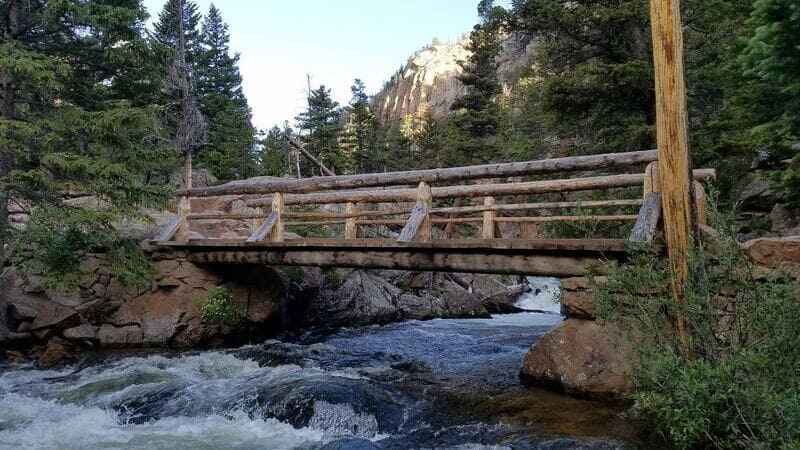
Park rules and policies
Stargazing in Rocky Mountain National Park can be a wonderful and memorable experience but comes with responsibilities and obligations. As a visitor and a stargazer, you need to follow and respect the park rules and policies designed to protect the park’s natural and cultural resources and the safety and enjoyment of all visitors.
Some of the park rules and policies that you need to follow and respect are:
- Entrance fee: You must pay an entrance fee to enter the park unless you have a valid pass or permit. The entrance fee is $25 per vehicle, $15 per person for a 7-day pass, or $70 for an annual pass. You can pay the entrance fee at any park’s entrance stations, visitor centers, or online. You need to display your receipt or pass on your dashboard or windshield when you park your vehicle in the park.
- Parking: You must only park your vehicle in designated parking areas and follow the parking signs and regulations. It would help if you avoided parking on roadsides, meadows, grasses, or vegetation, as they can damage the park’s environment and wildlife. You must also avoid parking in reserved areas for emergency vehicles, buses, or handicapped visitors.
- Camping: You need to camp only in designated campgrounds or backcountry campsites and follow the camping rules and regulations. You need to make a reservation and pay a fee for camping in the park, either online, by phone, or in person at any of the park’s visitor centers. You need to use a tent or an RV that meets the size and equipment requirements for each campground or campsite. You must also keep your campsite clean and secure and store your food and trash properly.
- Hiking: You need to hike on designated trails or routes only and follow the hiking rules and regulations. You need to stay on the trail or route at all times and avoid cutting switchbacks or creating new paths. You must also yield to other hikers and trail users, especially horses and bicycles. You must also be prepared for changing weather and terrain conditions and carry enough water, food, clothing, and equipment for your hike.
- Wildlife: You must always respect and protect the park’s wildlife and follow the wildlife rules and regulations. You must observe and photograph wildlife from a safe distance of at least 75 feet (23 meters) for most animals or 300 feet (91 meters) for bears and moose. It would be best if you also avoided feeding, touching, harassing, or disturbing wildlife in any way. You must also report any sick, injured, or dead wildlife to a ranger or a visitor center.
- Light pollution: You must always minimize your light pollution, especially when stargazing in the park. You need to use only red light sources when stargazing and turn off or dim any white light sources when not in use. You also need to cover or shield any visible light sources from outside your vehicle or tent, such as headlights, taillights, interior lights, or lanterns. It would help if you also respected other stargazers and visitors who may be disturbed by your light pollution.
Closing thoughts: Stargazing Rocky Mountain National Park

The magic of stargazing in the Colorado Rockies
Stargazing in Rocky Mountain National Park is a magical experience you will never forget. The park offers some of the best and darkest skies in the country, where you can see thousands of stars, planets, meteors, and galaxies. The park also offers a stunning and diverse landscape, where you can see mountains, lakes, forests, and meadows. The park also provides a rich and varied wildlife, where you can see elk, deer, moose, bears, and more.
Stargazing in Rocky Mountain National Park is a way to connect with nature and the universe and to appreciate its beauty and wonder. It’s also a way to connect with yourself and others and to enjoy a peaceful and relaxing time. It’s also a way to learn more about the night sky and astronomy and to discover new things and perspectives.
Benefits of connecting with nature through astronomy
Stargazing in Rocky Mountain National Park is fun and beneficial for your health and well-being. Stargazing in the park can provide you with many benefits, such as:
- Physical benefits: Stargazing in the park can improve your physical health by reducing your stress, blood pressure, heart rate, and inflammation. It can also boost your immune system, energy level, and sleep quality.
- Mental benefits: Stargazing in the park can improve your mental health by enhancing your mood, memory, creativity, and problem-solving skills. It can also reduce your anxiety, depression, boredom, and loneliness.
- Social benefits: Stargazing in the park can improve social health by strengthening relationships with family, friends, and partners. It can also increase your communication, cooperation, and empathy skills.
- Spiritual benefits: Stargazing in the park can improve your spiritual health by inspiring your awe, gratitude, curiosity, and wonder. It can also expand your awareness, perspective, and meaning of life.
Stargazing in Rocky Mountain National Park is an activity that can enrich your life in many ways. It can help you enjoy the present moment, appreciate the history, and anticipate the future possibilities. It can help you feel more alive, happy, and fulfilled.
Happy Stargazing!
Additional articles from my Dark Sky Parks series you may enjoy:
- Acadia National Park
- Anza-Borrego Desert State Park
- Arches National Park
- Big Bend National Park
- Bryce Canyon National Park
- Capulin Volcano Dark Sky Park
- Cherry Springs State Park
- Copper Breaks State Park
- Cosmic Campground Dark Sky Sanctuary
- Death Valley National Park
- Enchanted Rock State Natural Area
- Grand Canyon National Park
- Great Basin National Park
- Haleakala National Park
- Joshua Tree National Park
- Massacre Rim
- Olympic National Park
- Oracle State Park
- Red Rock Canyon State Park
- Tonopah Stargazing Park
- Yellowstone stargazing
- Zion National Park




